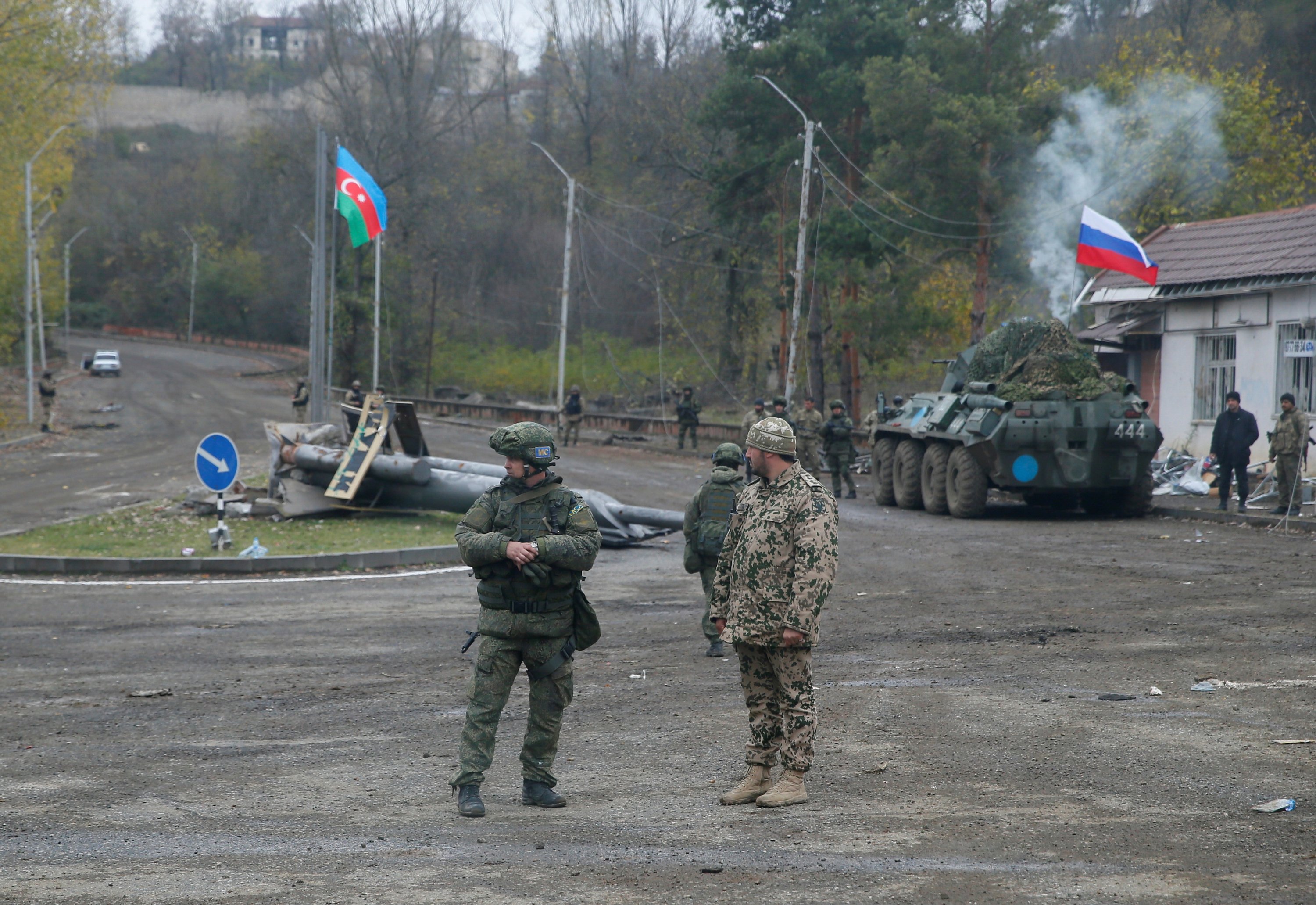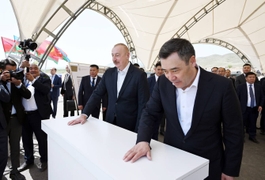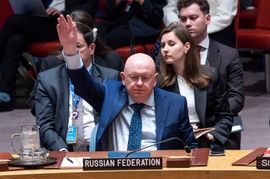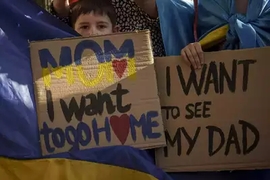Rotation of the Russian peacekeeping contingent in Karabakh (Garabagh) region of Azerbaijan is complete, Russia’s Defense Ministry said on Monday.
The finalization of the personnel rotation is part of the action plan enforced by the Russian ministry following the successful anti-terrorist measures conducted by the Azerbaijan Armed Forces in the Karabakh region in September.
“Rotation of the personnel of the Russian peacekeeping contingent is over. Weapons and vehicles have been sent to Russia for regular maintenance,” TASS reported, citing the ministry statement.
The Russian peacekeeping mission continues the assigned tasks in the Karabakh economic region of Azerbaijan, in constant interaction with Baku to ensure security and adherence to humanitarian law concerning civilians, the ministry said.
Earlier, dozens of peacekeepers’ observation posts in the Karabakh region were closed after Azerbaijani military reclaimed control over the entire region following the counter-terrorist measures in September.
The Russian peacekeepers have been present in the Karabakh region since November 2020, after Armenia and Azerbaijan agreed to cease hostilities through Russia’s mediation.
Armenia and Azerbaijan had been locked in a bloody conflict, which began in the late 1980s. The growing anti-Azerbaijan sentiments in Armenia were based on illegal claims to Azerbaijan’s historic Karabakh region.
Following the dissolution of the Soviet Union in 1991, Armenia launched a full-scale military aggression against Azerbaijan. The bloody war, which lasted until a ceasefire in 1994, resulted in Armenia occupying 20 percent of Azerbaijan’s internationally recognized territories. This occupation led to the deaths of over 30,000 Azerbaijanis and the expulsion of one million in a brutal ethnic cleansing campaign conducted by Armenia.
The conflict escalated on September 27, 2020, when Armenian forces illegally deployed in the occupied Azerbaijani lands began shelling military positions and civilian settlements of Azerbaijan. The Azerbaijani army promptly launched a counter-offensive to repel Armenia’s attack, liberating over 300 settlements, including the cities of Jabrayil, Fuzuli, Zangilan, Gubadli, and Shusha, from nearly 30 years of illegal Armenian occupation. The war concluded with a tripartite statement signed on November 10, 2020, by Armenia, Azerbaijan, and Russia. Under the statement, Armenia also returned the occupied Aghdam, Kalbajar, and Lachin districts to Azerbaijan.
As part of the agreement, a Russian peacekeeping mission was deployed in certain parts of the Karabakh region for five years. Their primary responsibility was monitoring and ensuring adherence to the peace in the region.
From 2020-2023, six Russian generals led the peacekeeping contingent, including incumbent Major-General Kirill Kulakov, who assumed his role in April of this year.
Concerns against the Russian peacekeepers have been raised multiple times, for their failure to enforce assigned tasks. For instance, Paragraph 4 of the tripartite statement mandates the peacekeepers to ensure the immediate withdrawal of the Armenian army formations from the Karabakh region, however, this went unfulfilled over the past three years.
Moreover, the post-war situation in the Karabakh region remained fragile due to frequent armed provocations by the Armenian military and illegal armed formations in the region. Azerbaijani army positions in the liberated territories, including the posts on the conditional border with Armenia, were targeted almost daily, leading to periodical fatal escalations, including the bloody border clashes in 2021 and 2022.
The peacekeepers were also observed accompanying illegal arms shipments from Armenia to the Karabakh region, despite warnings from Azerbaijan.
After Azerbaijan regained full control over the Lachin road, the peacekeepers and illegal armed groups in the region were seen using dirt roads to bypass the Lachin highway for illegal transfers.
Meanwhile, the illegal Armenian separatist forces in the Karabakh region intensively fortified their positions and strongholds with materiel supplied by Armenia. Despite the continuous warnings by Baku, neither the peacekeepers nor the separatist troops addressed the legal demands.
Azerbaijan Armed Forces conducted on September 19-20 local anti-terrorist measures to neutralize illegal Armenian armed formations and their military infrastructure in the Karabakh region.
By the time of the cessation of the one-day operation on September 20, the Azerbaijani military disabled artillery systems, radio-electronic warfare, military equipment, ammunition depots, military strongholds, and shelters of the Armenian army formations stationed in the Karabakh region of Azerbaijan.
In addition, more than 90 combat posts and strategically important positions of the Armenian military formations were taken under control during the operation. Seven military vehicles, four mortars, one tank, two infantry fighting vehicles, as well as a large number of weapons and ammunition were seized.
On September 20, the Defence Ministry of Azerbaijan announced the end of the local counter-terrorism measures in the Karabakh region after the separatists agreed to complete disarmament by withdrawing from their positions, laying down arms, and handing over military equipment. On the same day, the Azerbaijani army launched immediate confiscation of weapons, ammunition, and equipment.
On September 21, the Azerbaijani authorities hosted the representatives of Karabakh’s Armenian residents to discuss their reintegration into Azerbaijani society. However, despite Baku’s calls to stay and reintegrate, as well as pledges to guarantee all fundamental rights, a large portion of the Armenian residents have voluntarily left the Karabakh region for Armenia.
On September 28, the so-called leadership of the Armenian separatist regime in the Karabakh region announced its self-dissolution. A decree was signed by the regime's self-proclaimed "president," Samvel Shahramanyan. It also called on the Armenian residents of the Karabakh region to become acquainted with the conditions of reintegration presented by Azerbaijan, in order to subsequently make an independent and individual decision on the possibility of staying in (or returning to) the Karabakh region.







 President Ilham Aliyev shed light on the evolving contours of the peace process with Armenia during an international conference in Baku this week. ...
President Ilham Aliyev shed light on the evolving contours of the peace process with Armenia during an international conference in Baku this week. ...
 Azerbaijan and Armenia started the process of demarcation of their border on Tuesday, with the installation of the first border markers based on ge...
Azerbaijan and Armenia started the process of demarcation of their border on Tuesday, with the installation of the first border markers based on ge...
 Iranian President Ebrahim Raisi expressed Tehran’s readiness to participate in significant development projects in Sri Lanka during the inauguratio...
Iranian President Ebrahim Raisi expressed Tehran’s readiness to participate in significant development projects in Sri Lanka during the inauguratio...
 As the conflict between Ukraine and Russia escalates, the strategic importance of Kharkiv, Ukraine's second-largest city, has come sharply into focus.
As the conflict between Ukraine and Russia escalates, the strategic importance of Kharkiv, Ukraine's second-largest city, has come sharply into focus.
 Iran and Pakistan have signed eight cooperation documents in various fields, and agreed to strengthen ties to fight terrorism in the region.
Iran and Pakistan have signed eight cooperation documents in various fields, and agreed to strengthen ties to fight terrorism in the region.



